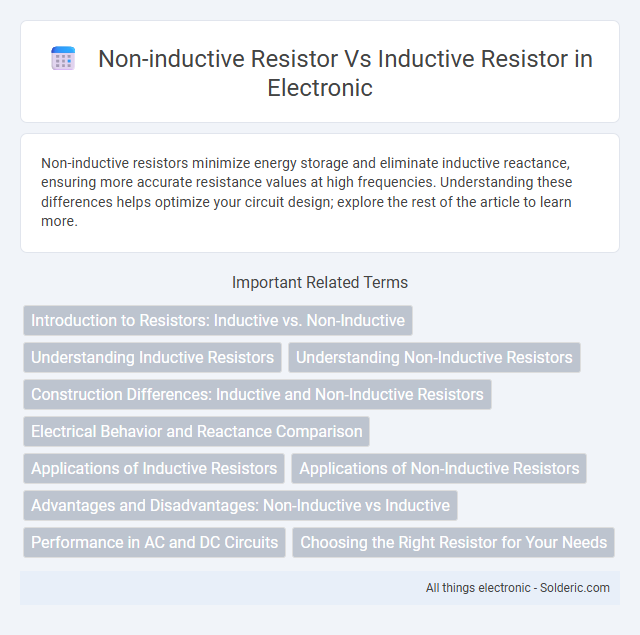Non-inductive resistors minimize energy storage and eliminate inductive reactance, ensuring more accurate resistance values at high frequencies. Understanding these differences helps optimize your circuit design; explore the rest of the article to learn more.
Comparison Table
| Feature | Non-Inductive Resistor | Inductive Resistor |
|---|---|---|
| Definition | Resistor designed to minimize inductance | Resistor with inherent inductive properties |
| Inductance | Very low or near zero inductance | Significant inductance due to coil-like winding |
| Frequency Response | Stable resistance at high frequencies | Resistance varies with frequency, can cause phase shift |
| Applications | High-frequency circuits, precision measurement | Filters, tuned circuits, energy storage in inductors |
| Construction | Non-coiled elements, special winding techniques | Coiled wire or spiral elements |
| Typical Use | RF circuits, oscillators | Power electronics, chokes |
| Cost | Generally higher due to specialized design | Typically lower, standard resistor manufacturing |
Introduction to Resistors: Inductive vs. Non-Inductive
Non-inductive resistors are designed to minimize inductance by using coil arrangements or special materials, making them ideal for high-frequency circuits where signal integrity is crucial. Inductive resistors, on the other hand, possess inherent inductance due to their coil construction, causing impedance that can affect performance in AC applications. Understanding your circuit requirements helps determine whether a non-inductive or inductive resistor is the best choice for achieving precise resistance without undesired inductive effects.
Understanding Inductive Resistors
Inductive resistors differ from non-inductive resistors by incorporating coil-like windings that introduce inductance alongside resistance, affecting how they respond to alternating current (AC) signals. Understanding inductive resistors is crucial when designing circuits requiring precise impedance control, as their inductive reactance can cause phase shifts and signal distortion at higher frequencies. Selecting the right resistor type ensures Your circuit maintains desired performance characteristics, especially in high-frequency or sensitive electronic applications.
Understanding Non-Inductive Resistors
Non-inductive resistors are designed to minimize inductance, making them ideal for high-frequency applications where precise resistance without reactive impedance is critical. Unlike inductive resistors, which have inherent coil-like properties causing inductance, non-inductive resistors use construction techniques such as bifilar winding or metal film to cancel out magnetic fields. Understanding non-inductive resistors involves recognizing their role in reducing signal distortion and maintaining circuit stability in RF and high-speed electronics.
Construction Differences: Inductive and Non-Inductive Resistors
Non-inductive resistors are designed with a construction that minimizes magnetic fields by arranging resistive elements in a way that cancels inductance, often using bifilar winding or non-coiled wire patterns. Inductive resistors, in contrast, typically have coiled wire configurations or spiral windings that inherently create inductance due to magnetic field generation around the coils. Your choice between these types depends on the need to suppress inductive reactance in high-frequency circuits or tolerate it in standard applications.
Electrical Behavior and Reactance Comparison
Non-inductive resistors exhibit pure resistive behavior with negligible reactance, making them ideal for AC circuits where minimal phase shift is required. Inductive resistors, however, combine resistance with inductive reactance due to their coil-like construction, causing voltage and current to become out of phase and increasing impedance at higher frequencies. Understanding this distinction helps you select the appropriate resistor type based on your circuit's frequency response and performance needs.
Applications of Inductive Resistors
Inductive resistors, used in applications such as power supplies, audio equipment, and RF circuits, provide both resistance and inductance to manage current flow and filter high-frequency signals effectively. They are essential in smoothing current in switching regulators, suppressing noise in audio amplifiers, and tuning circuits in radio frequency devices. Your choice of inductive resistors enhances performance where controlled impedance and energy storage are critical.
Applications of Non-Inductive Resistors
Non-inductive resistors are predominantly used in high-frequency circuits, precision measurement devices, and power supplies where minimal inductance is crucial to maintain signal integrity. These resistors are ideal for applications such as RF amplifiers, oscillators, and pulse circuits, where inductive reactance can cause signal distortion or phase shift. Your electronic designs benefit from non-inductive resistors by ensuring accurate resistance performance without unwanted inductive effects.
Advantages and Disadvantages: Non-Inductive vs Inductive
Non-inductive resistors offer advantages in high-frequency applications due to their minimal inductance, ensuring stable resistance and reduced signal distortion, which benefits your precision circuits. However, they generally have lower power ratings and higher costs compared to inductive resistors, which excel in handling high power and dissipating heat effectively but introduce unwanted inductance affecting performance in high-frequency environments. Choosing between non-inductive and inductive resistors depends on your specific application requirements, balancing factors like frequency response, power handling, and physical size.
Performance in AC and DC Circuits
Non-inductive resistors provide stable resistance in both AC and DC circuits by minimizing inductance, making them ideal for high-frequency applications where signal integrity is critical. Inductive resistors, containing inherent inductance, affect AC performance by adding reactance that can distort signal behavior but perform normally in DC circuits where inductance has minimal impact. Your choice depends on whether minimizing inductive effects is crucial for accurate AC signal control or if standard resistance suffices in DC environments.
Choosing the Right Resistor for Your Needs
Non-inductive resistors provide stable resistance values with minimal inductance, making them ideal for high-frequency applications and precision circuits where signal integrity is crucial. Inductive resistors, often wire-wound, exhibit significant inductance that can affect performance in AC or rapidly changing signal environments but excel in power dissipation and surge tolerance. You should choose a non-inductive resistor for tasks requiring accurate frequency response and an inductive resistor for power handling and thermal stability.
Non-inductive resistor vs inductive resistor Infographic

 solderic.com
solderic.com